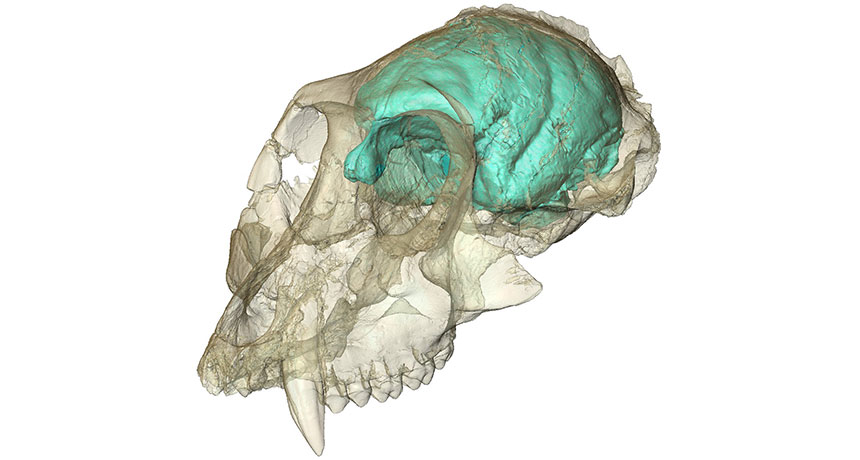Monkey’s small brain shows surprising folds
Victoriapithecus fossil skull may modify story of primate evolution

WRINKLES IN TIME A 3-D computer image shows folds on the reconstructed brain surface, in green, of Victoriapithecus, a 15-million-year-old African monkey.
Max PIanck Institute for Evolutionary Anthropology, Fred Spoor
Thanks to modern technology, a 15-million-year-old monkey skull has added surprising new wrinkles to primate brain evolution.
A digital analysis of the fossil finds that this ancient African monkey possessed a tiny brain that nonetheless was folded in a pattern observed in the much larger brains of its present-day descendants.
Although tissue folding accompanied increases in brain size among human ancestors, wrinkling emerged on its own in the ancient monkey’s plum-sized brain, biological anthropologist Lauren Gonzales of Duke University and her colleagues report July 3 in Nature Communications. Many researchers regard the folds as signs of complex organization within large brains.
“Evidence from the brain of Victoriapithecus shows that cerebral complexity and brain size evolved independently in these monkeys,” Gonzales says. In short, bigger brains aren’t always needed to produce more powerful brains.
In an another surprise, a brain section crucial for detecting smells, the olfactory bulb, was three times as large in the extinct primate as in living monkeys of comparable size, Gonzales’ group says. A section of folded tissue linked to color vision in modern macaque monkeys also appears in the fossil monkey’s reconstructed brain.
Excavations in 1997 on an island in Kenya’s Lake Victoria yielded the skull, assigned to the genus Victoriapithecus. It’s the oldest known monkey skull from Africa, Asia and Europe.
Using a high-resolution scanner, the researchers digitally reconstructed the surface of Victoriapithecus’ brain based on impressions left on the fossil braincase’s inner surface.
Skull measurements indicate that Victoriapithecus was roughly the size of present-day vervet monkeys, Gonzales says. Vervet monkeys’ brain volumes range from around 59 cubic centimeters to 71 cubic centimeters. In Victoriapithecus, brain volume reaches only 36 cubic centimeters.
The unexpected discovery of an unusually large olfactory bulb in a small brain folded like those of living monkeys “is a really important finding,” says paleoanthropologist Christoph Zollikofer of the University of Zurich in Switzerland. But it’s unclear if Victoriapithecus’ wrinkled brain reflected upgrades in brain organization and thinking abilities, he cautions.
Despite the new evidence, primate evolution remains poorly understood, says neurobiologist Christine Charvet of George Washington University in Washington, D.C. It’s possible that African monkeys started out with small, Victoriapithecus-like brains featuring large olfactory bulbs and gradually evolved larger brains devoted more to vision than smell. Or, Charvet suggests, a common ancestor of monkeys and apes could have had a small olfactory bulb that expanded and contracted in size several times over the course of primate evolution.
Gonzales’ findings may relate to a major controversy in hominid evolution — the proposed existence of a diminutive Homo species known as hobbits. A hobbit’s digitally reconstructed brain surface displays folds indicating humanlike mental capacities in a chimp-sized brain (SN: 4/25/09, p. 9), says paleoanthropologist Dean Falk of Florida State University in Tallahassee. Evidence from Victoriapithecus further suggests that neural modifications can boost learning and memory in small-brained primates, Falk adds.
A recent study suggests that the surface area and thickness of a brain’s outer layer determine whether and how it folds (SN: 7/25/15). If that’s true, wrinkles in the hobbit brain — and perhaps those in the ancient monkey brain as well — may reflect basic physical forces rather than underlying neural changes, Zollikofer says. In that case, Gonzales’ suggestion that brain folding can evolve independently of brain size appears unlikely, remarks behavioral ecologist Robert Barton of Durham University in England.







